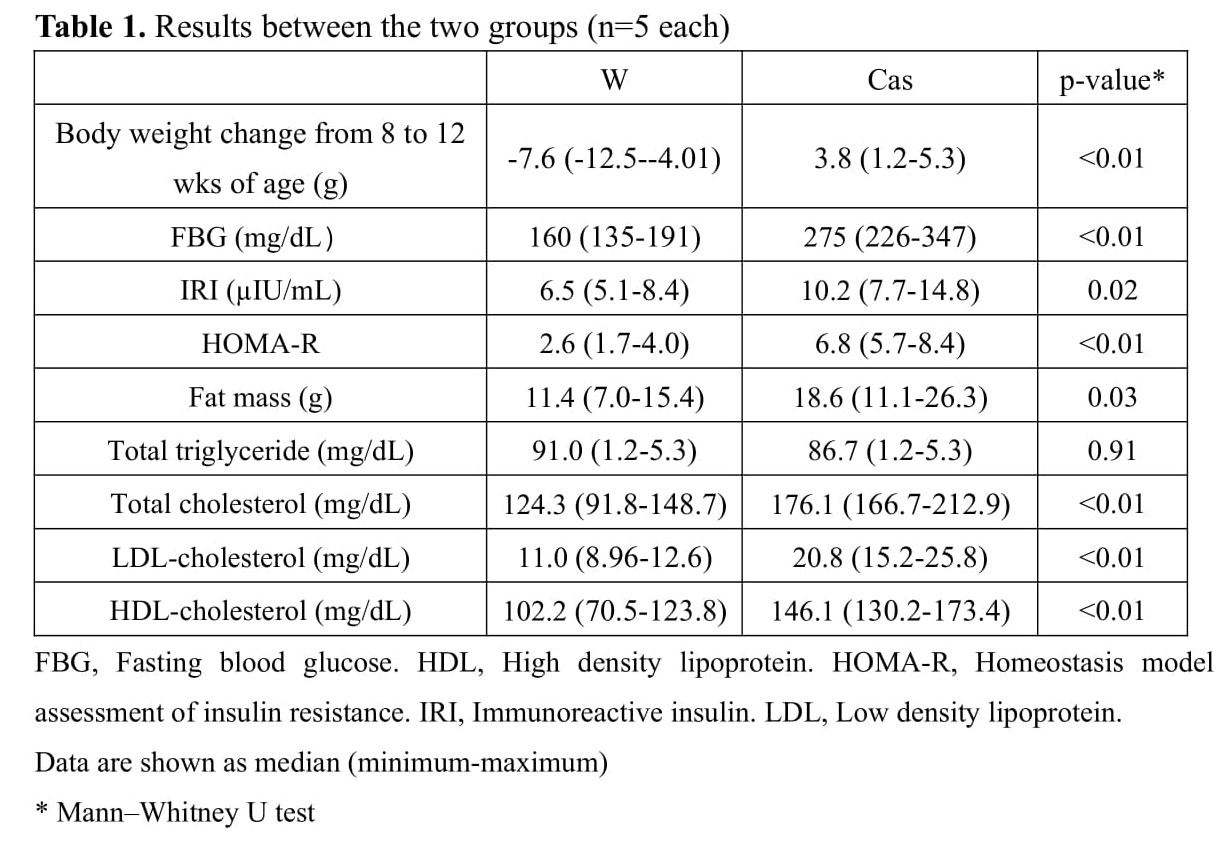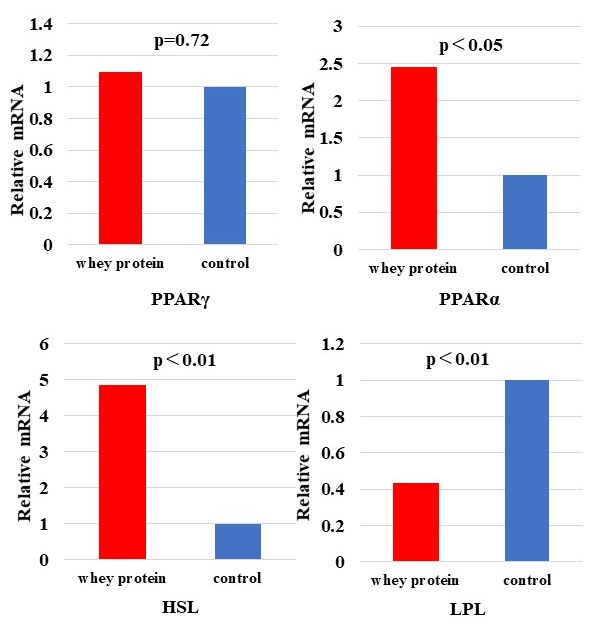Back
Endocrinology: Type 2 Diabetes (T2 DM)
Category: Abstract Submission
Endocrinology I
532 - Whey protein improves lipid metabolism in obese mice fed a high-fat diet
Friday, April 22, 2022
6:15 PM – 8:45 PM US MT
Poster Number: 532
Publication Number: 532.107
Publication Number: 532.107
Nobuhiko Nagano, Department of Pediatrics and Child Health, Nihon University School of Medicine, Tokyo, Tokyo, Japan; Kimitaka Nakazaki, Department of Pediatrics and Child Health, Nihon University School of Medicine, Tokyo, itabashiku, Tokyo, Japan; Daichi Katayama, Department of Pediatrics and Child Health, Nihon University School of Medicine, Toky, tokyo, Tokyo, Japan; Shoichi Shimizu, Department of Pediatrics and Child Health, Nihon University School of Medicine, Itabashi, Tokyo, Japan; Hajime Sasaki, Kanagawa Institute of Techonolgy, Atsugi, Kanagawa, Japan; Tomoo Okada, Kanagawa institute of technology, ATSUGI, Kanagawa, Japan; Ichiro Morioka, Nihon University School of Medicine, Itabashi, Tokyo, Japan
- KN
Kimitaka Nakazaki, none
n/a
Department of Pediatrics and Child Health, Nihon University School of Medicine, Tokyo
fuchu, Tokyo, Japan
Presenting Author(s)
Background: Childhood obesity is associated with the development of juvenile type 2 diabetes and lifestyle-related diseases. In recent years, it has been reported that whey protein has antioxidant properties and can improve abnormal glycolipid metabolism by increasing the expression of glutathione and fibroblast growth factor 21. However, the effect on lipid metabolism in obesity is still not clear.
Objective: To study if whey protein can improve lipid metabolism in obese mice fed a high-fat diet.
Design/Methods: This study was conducted with the approval of our animal ethics committee. Pregnant ICR mice were fed a high-fat diet from 24h post-confirmation of the presence of a vaginal plug. After birth, pups were fed by their mothers, who were given a high-fat diet. After weaning at 4 wks, a high-fat diet was given directly to the mice and then divided into those receiving: a casein or control (Cas) diet (n=5); and a whey (W) diet (n=5). At 12 wks of age, body weight, fat mass, fasting blood glucose (FBG), insulin (IRI), HOMA-R, cholesterol (Cho), and triglyceride (TG), and mRNA expression levels of peroxisome proliferator-activated receptor (PPAR) γ, α, hormone sensitive lipase (HSL) and lipoprotein lipase (LPL) in the liver tissues were measured and compared between the two groups.
Results: From 8 to 12 wks of age, Group W mice lost weight, while Group Cas mice gained. FBG, IRI, and HOMA-R levels and fat mass were significantly lower in Group W mice.TG was not different between the two groups, but T-Cho, LDL-Cho, and LPL were significantly lower in group W (Table 1). PPARα and HSL were higher in Group W, but no significant difference was found in PPARγ (Figure 1).Conclusion(s): Whey protein enhanced lipolysis of adipocytes and fatty acid uptake into skeletal muscle due to increased expression of lipid-metabolizing enzymes. We speculate that whey protein ameliorates high-fat-diet-induced obesity and insulin resistance by accelerating lipid metabolism gene expression.
Results between the two groups
mRNA expression levels of lipid-metabolizing enzymes in the liver tissues
Objective: To study if whey protein can improve lipid metabolism in obese mice fed a high-fat diet.
Design/Methods: This study was conducted with the approval of our animal ethics committee. Pregnant ICR mice were fed a high-fat diet from 24h post-confirmation of the presence of a vaginal plug. After birth, pups were fed by their mothers, who were given a high-fat diet. After weaning at 4 wks, a high-fat diet was given directly to the mice and then divided into those receiving: a casein or control (Cas) diet (n=5); and a whey (W) diet (n=5). At 12 wks of age, body weight, fat mass, fasting blood glucose (FBG), insulin (IRI), HOMA-R, cholesterol (Cho), and triglyceride (TG), and mRNA expression levels of peroxisome proliferator-activated receptor (PPAR) γ, α, hormone sensitive lipase (HSL) and lipoprotein lipase (LPL) in the liver tissues were measured and compared between the two groups.
Results: From 8 to 12 wks of age, Group W mice lost weight, while Group Cas mice gained. FBG, IRI, and HOMA-R levels and fat mass were significantly lower in Group W mice.TG was not different between the two groups, but T-Cho, LDL-Cho, and LPL were significantly lower in group W (Table 1). PPARα and HSL were higher in Group W, but no significant difference was found in PPARγ (Figure 1).Conclusion(s): Whey protein enhanced lipolysis of adipocytes and fatty acid uptake into skeletal muscle due to increased expression of lipid-metabolizing enzymes. We speculate that whey protein ameliorates high-fat-diet-induced obesity and insulin resistance by accelerating lipid metabolism gene expression.
Results between the two groups

mRNA expression levels of lipid-metabolizing enzymes in the liver tissues

